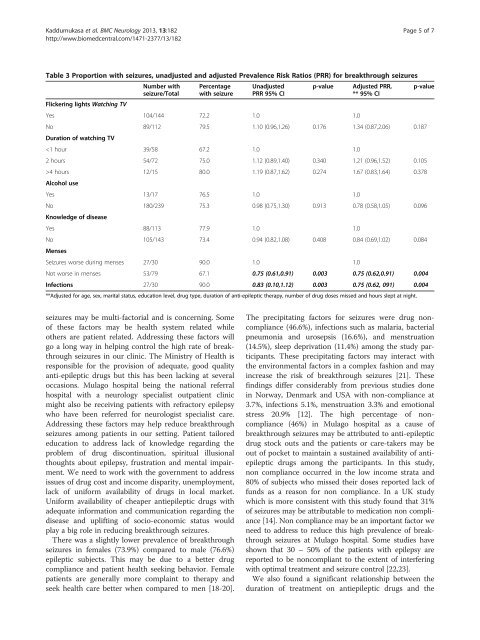The frequency and precipitating factors for breakthrough seizures ...
The frequency and precipitating factors for breakthrough seizures ...
The frequency and precipitating factors for breakthrough seizures ...
Create successful ePaper yourself
Turn your PDF publications into a flip-book with our unique Google optimized e-Paper software.
Kaddumukasa et al. BMC Neurology 2013, 13:182 Page 5 of 7<br />
http://www.biomedcentral.com/1471-2377/13/182<br />
Table 3 Proportion with <strong>seizures</strong>, unadjusted <strong>and</strong> adjusted Prevalence Risk Ratios (PRR) <strong>for</strong> <strong>breakthrough</strong> <strong>seizures</strong><br />
Number with<br />
seizure/Total<br />
Percentage<br />
with seizure<br />
Unadjusted<br />
PRR 95% CI<br />
p-value<br />
Adjusted PRR,<br />
** 95% CI<br />
Flickering lights Watching TV<br />
Yes 104/144 72.2 1.0 1.0<br />
No 89/112 79.5 1.10 (0.96,1.26) 0.176 1.34 (0.87,2.06) 0.187<br />
Duration of watching TV<br />
4 hours 12/15 80.0 1.19 (0.87,1.62) 0.274 1.67 (0.83,1.64) 0.378<br />
Alcohol use<br />
Yes 13/17 76.5 1.0 1.0<br />
No 180/239 75.3 0.98 (0.75,1.30) 0.913 0.78 (0.58,1.05) 0.096<br />
Knowledge of disease<br />
Yes 88/113 77.9 1.0 1.0<br />
No 105/143 73.4 0.94 (0.82,1.08) 0.408 0.84 (0.69,1.02) 0.084<br />
Menses<br />
Seizures worse during menses 27/30 90.0 1.0 1.0<br />
Not worse in menses 53/79 67.1 0.75 (0.61,0.91) 0.003 0.75 (0.62,0.91) 0.004<br />
Infections 27/30 90.0 0.83 (0.10,1.12) 0.003 0.75 (0.62, 091) 0.004<br />
**Adjusted <strong>for</strong> age, sex, marital status, education level, drug type, duration of anti-epileptic therapy, number of drug doses missed <strong>and</strong> hours slept at night.<br />
p-value<br />
<strong>seizures</strong> may be multi-factorial <strong>and</strong> is concerning. Some<br />
of these <strong>factors</strong> may be health system related while<br />
others are patient related. Addressing these <strong>factors</strong> will<br />
go a long way in helping control the high rate of <strong>breakthrough</strong><br />
<strong>seizures</strong> in our clinic. <strong>The</strong> Ministry of Health is<br />
responsible <strong>for</strong> the provision of adequate, good quality<br />
anti-epileptic drugs but this has been lacking at several<br />
occasions. Mulago hospital being the national referral<br />
hospital with a neurology specialist outpatient clinic<br />
might also be receiving patients with refractory epilepsy<br />
who have been referred <strong>for</strong> neurologist specialist care.<br />
Addressing these <strong>factors</strong> may help reduce <strong>breakthrough</strong><br />
<strong>seizures</strong> among patients in our setting. Patient tailored<br />
education to address lack of knowledge regarding the<br />
problem of drug discontinuation, spiritual illusional<br />
thoughts about epilepsy, frustration <strong>and</strong> mental impairment.<br />
We need to work with the government to address<br />
issues of drug cost <strong>and</strong> income disparity, unemployment,<br />
lack of uni<strong>for</strong>m availability of drugs in local market.<br />
Uni<strong>for</strong>m availability of cheaper antiepileptic drugs with<br />
adequate in<strong>for</strong>mation <strong>and</strong> communication regarding the<br />
disease <strong>and</strong> uplifting of socio-economic status would<br />
play a big role in reducing <strong>breakthrough</strong> <strong>seizures</strong>.<br />
<strong>The</strong>re was a slightly lower prevalence of <strong>breakthrough</strong><br />
<strong>seizures</strong> in females (73.9%) compared to male (76.6%)<br />
epileptic subjects. This may be due to a better drug<br />
compliance <strong>and</strong> patient health seeking behavior. Female<br />
patients are generally more complaint to therapy <strong>and</strong><br />
seek health care better when compared to men [18-20].<br />
<strong>The</strong> <strong>precipitating</strong> <strong>factors</strong> <strong>for</strong> <strong>seizures</strong> were drug noncompliance<br />
(46.6%), infections such as malaria, bacterial<br />
pneumonia <strong>and</strong> urosepsis (16.6%), <strong>and</strong> menstruation<br />
(14.5%), sleep deprivation (11.4%) among the study participants.<br />
<strong>The</strong>se <strong>precipitating</strong> <strong>factors</strong> may interact with<br />
the environmental <strong>factors</strong> in a complex fashion <strong>and</strong> may<br />
increase the risk of <strong>breakthrough</strong> <strong>seizures</strong> [21]. <strong>The</strong>se<br />
findings differ considerably from previous studies done<br />
in Norway, Denmark <strong>and</strong> USA with non-compliance at<br />
3.7%, infections 5.1%, menstruation 3.3% <strong>and</strong> emotional<br />
stress 20.9% [12]. <strong>The</strong> high percentage of noncompliance<br />
(46%) in Mulago hospital as a cause of<br />
<strong>breakthrough</strong> <strong>seizures</strong> may be attributed to anti-epileptic<br />
drug stock outs <strong>and</strong> the patients or care-takers may be<br />
out of pocket to maintain a sustained availability of antiepileptic<br />
drugs among the participants. In this study,<br />
non compliance occurred in the low income strata <strong>and</strong><br />
80% of subjects who missed their doses reported lack of<br />
funds as a reason <strong>for</strong> non compliance. In a UK study<br />
which is more consistent with this study found that 31%<br />
of <strong>seizures</strong> may be attributable to medication non compliance<br />
[14]. Non compliance may be an important factor we<br />
need to address to reduce this high prevalence of <strong>breakthrough</strong><br />
<strong>seizures</strong> at Mulago hospital. Some studies have<br />
shown that 30 – 50% of the patients with epilepsy are<br />
reported to be noncompliant to the extent of interfering<br />
with optimal treatment <strong>and</strong> seizure control [22,23].<br />
We also found a significant relationship between the<br />
duration of treatment on antiepileptic drugs <strong>and</strong> the
















